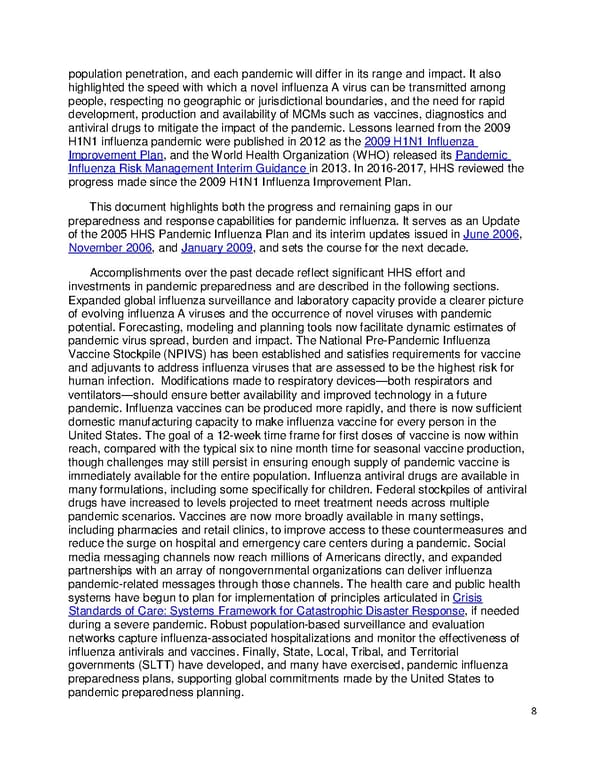population penetration, and each pandemic will differ in its range and impact. It also highlighted the speed with which a novel influenza A virus can be transmitted among people, respecting no geographic or jurisdictional boundaries, and the need for rapid development, production and availability of MCMs such as vaccines, diagnostics and antiviral drugs to mitigate the impact of the pandemic. Lessons learned from the 2009 H1N1 influenza pandemic were published in 2012 as the 2009 H1N1 Influenza Improvement Plan, and the World Health Organization (WHO) released its Pandemic Influenza Risk Management Interim Guidance in 2013. In 2016-2017, HHS reviewed the progress made since the 2009 H1N1 Influenza Improvement Plan. This document highlights both the progress and remaining gaps in our preparedness and response capabilities for pandemic influenza. It serves as an Update , of the 2005 HHS Pandemic Influenza Plan and its interim updates issued in June 2006 November 2006, and January 2009, and sets the course for the next decade. Accomplishments over the past decade reflect significant HHS effort and investments in pandemic preparedness and are described in the following sections. Expanded global influenza surveillance and laboratory capacity provide a clearer picture of evolving influenza A viruses and the occurrence of novel viruses with pandemic potential. Forecasting, modeling and planning tools now facilitate dynamic estimates of pandemic virus spread, burden and impact. The National Pre-Pandemic Influenza Vaccine Stockpile (NPIVS) has been established and satisfies requirements for vaccine and adjuvants to address influenza viruses that are assessed to be the highest risk for human infection. Modifications made to respiratory devices—both respirators and ventilators—should ensure better availability and improved technology in a future pandemic. Influenza vaccines can be produced more rapidly, and there is now sufficient domestic manufacturing capacity to make influenza vaccine for every person in the United States. The goal of a 12-week time frame for first doses of vaccine is now within reach, compared with the typical six to nine month time for seasonal vaccine production, though challenges may still persist in ensuring enough supply of pandemic vaccine is immediately available for the entire population. Influenza antiviral drugs are available in many formulations, including some specifically for children. Federal stockpiles of antiviral drugs have increased to levels projected to meet treatment needs across multiple pandemic scenarios. Vaccines are now more broadly available in many settings, including pharmacies and retail clinics, to improve access to these countermeasures and reduce the surge on hospital and emergency care centers during a pandemic. Social media messaging channels now reach millions of Americans directly, and expanded partnerships with an array of nongovernmental organizations can deliver influenza pandemic-related messages through those channels. The health care and public health systems have begun to plan for implementation of principles articulated in Crisis Standards of Care: Systems Framework for Catastrophic Disaster Response, if needed during a severe pandemic. Robust population-based surveillance and evaluation networks capture influenza-associated hospitalizations and monitor the effectiveness of influenza antivirals and vaccines. Finally, State, Local, Tribal, and Territorial governments (SLTT) have developed, and many have exercised, pandemic influenza preparedness plans, supporting global commitments made by the United States to pandemic preparedness planning. 8
 Pandemic Influenza Plan Page 7 Page 9
Pandemic Influenza Plan Page 7 Page 9